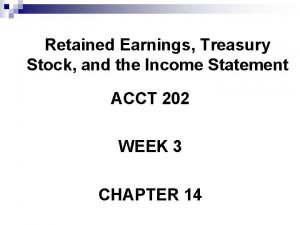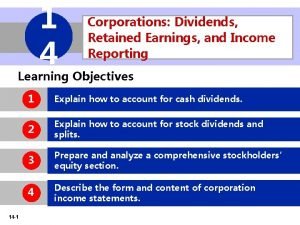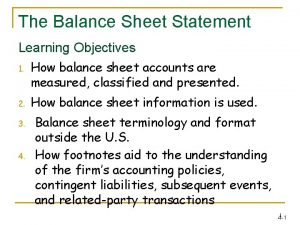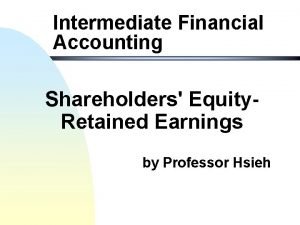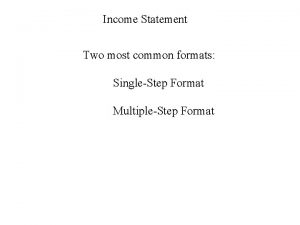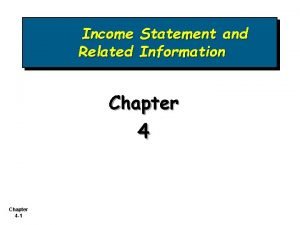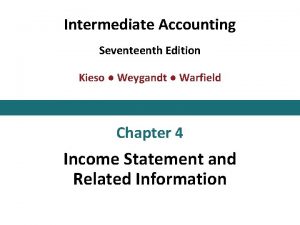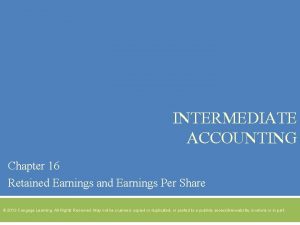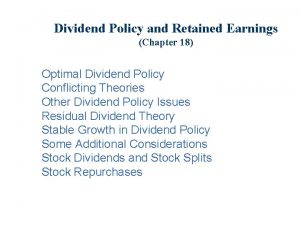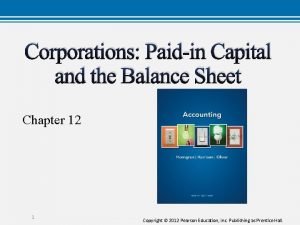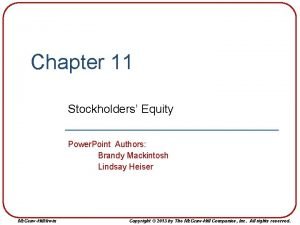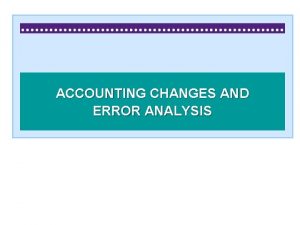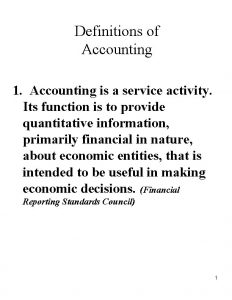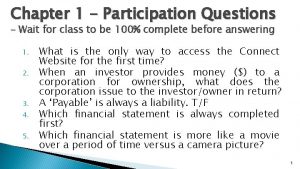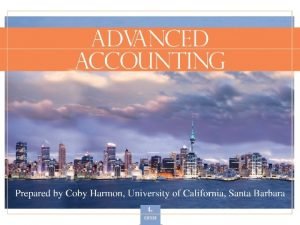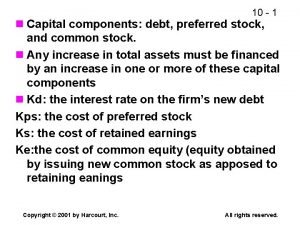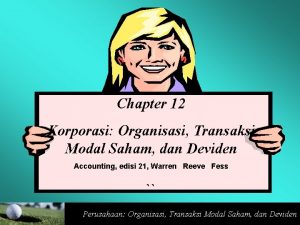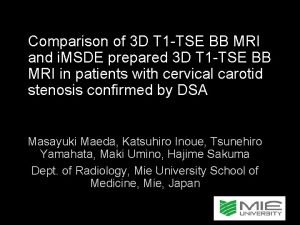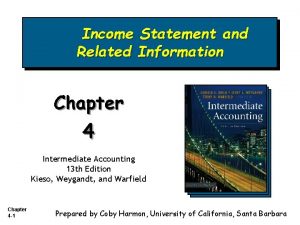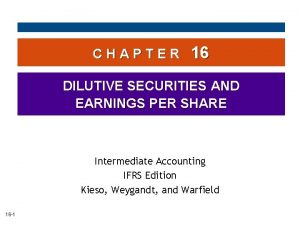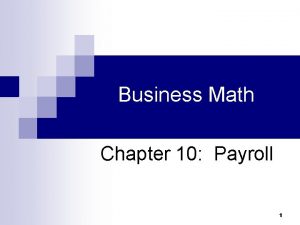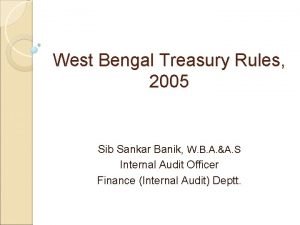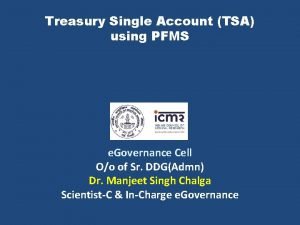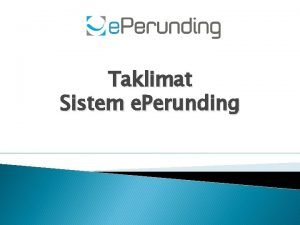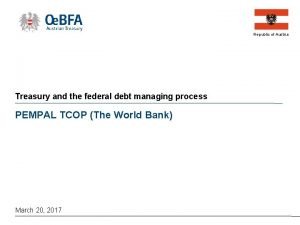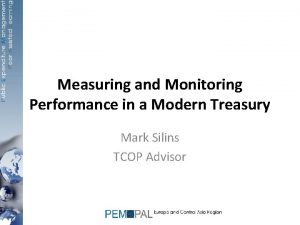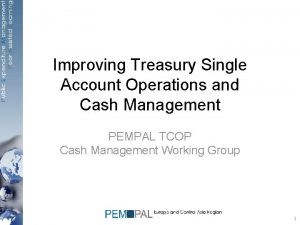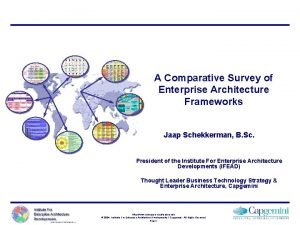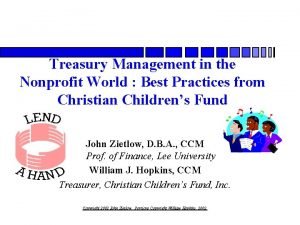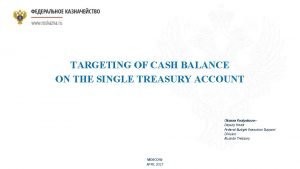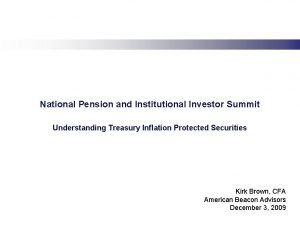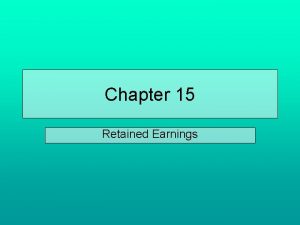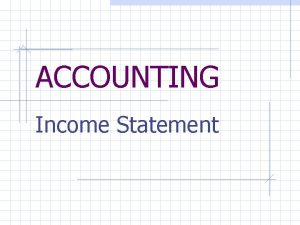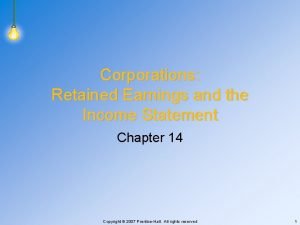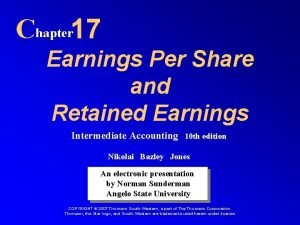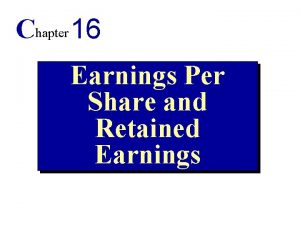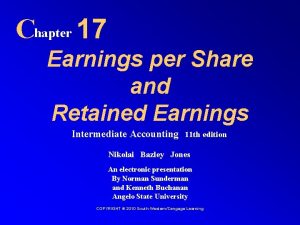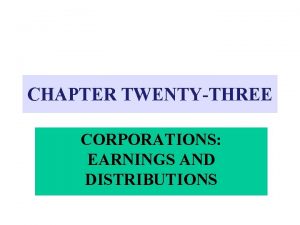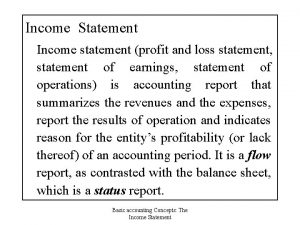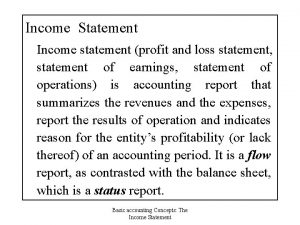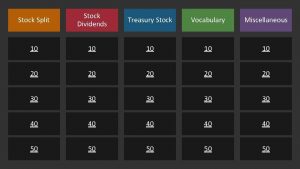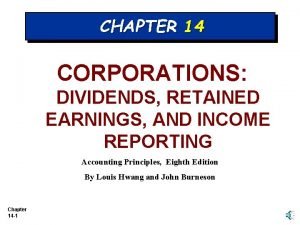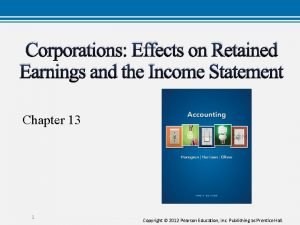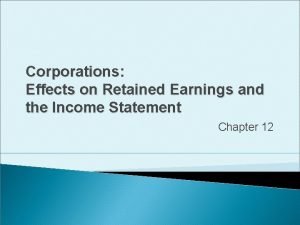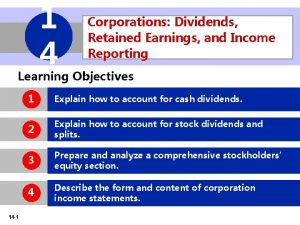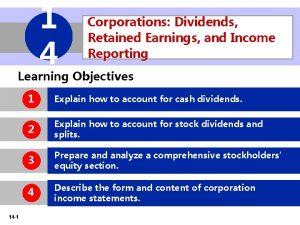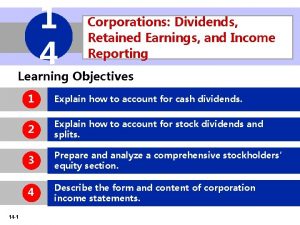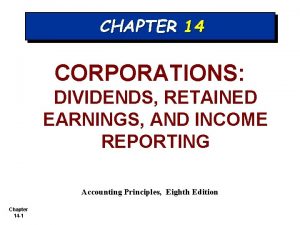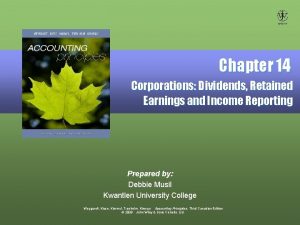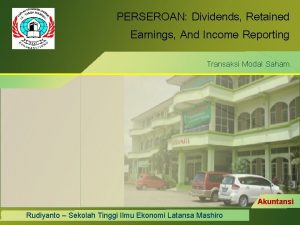Retained Earnings Treasury Stock and the Income Statement



















































- Slides: 51

Retained Earnings, Treasury Stock, and the Income Statement Chapter 14

Retained Earnings and Dividends Retained Earnings shows the amount of income allowed to accumulate from the beginning of the corporation’s life to the present. l Retained Earnings represents a claim on assets, but it is not cash. l

Retained Earnings and Dividends The balance in the Income Summary account is closed to Retained Earnings at period end. l Dividends are distributions to the stockholders. l To declare dividends there must be adequate retained earnings. l

Objective 1 Account for stock dividends.

Stock Dividends What are stock dividends? l They are a proportional distribution of a corporation’s own stock to shareholders. l They do not change total stockholders’ equity. l A stock dividend is a transfer of retained earnings to contributed capital. l

Small Stock Dividend Example The dividend is valued at the product of the number of shares distributed times the market price at declaration date. l San Diego Company, with 300, 000 shares of $2 par value common stock outstanding, declares a 15% stock dividend when the shares are trading at $20. l

Small Stock Dividend Example How much stock do the shareholders receive? l 300, 000 × 15% = 45, 000 shares l 45, 000 at $20 per share = $900, 000, and 45, 000 at $2 per share = $90, 000 l What is the entry when the dividend is distributed?

Small Stock Dividend Example Retained Earnings 900, 000 Common Stock 90, 000 Paid-in Capital in Excess of Par 810, 000 15% common stock dividend distributed

Large Stock Dividend This significantly increases the number of shares outstanding and is likely to reduce the per share price. l A common practice is to transfer the par value of the dividend shares from Retained Earnings to Common Stock. l

Large Stock Dividend Example A 50% dividend is declared on a company’s $1 par value common. l There are 200, 000 shares outstanding. l Retained Earnings 100, 000 Common Stock 100, 000 50% common stock dividend distributed

Stock Split This is an increase in the number of authorized, issued, and outstanding shares. l It is a reduction in the par value. l The market value is usually affected proportionately. l

Stock Split A 5 -for-1 stock split means that the company would have five times as many shares outstanding after the split as it had before. l Each share’s par value would be divided by five. l

Stock Split Example Prior to a 5 -for-1 split, San Diego Company had 500, 000 shares of $10 par common stock authorized and 100, 000 issued. l After the split, 2, 500, 000 are authorized. l 500, 000 are issued. l What is the par value per share? l $10 ÷ 5 = $2 l

Objective 2 Distinguish stock splits from stock dividends.

Similarities Between Stock Splits and Stock Dividends Both increase the number of shares of stock owned per stockholder. Neither change the investor’s cost of the stock they own. Neither type of income creates taxable income for the investor.

Differences Between Stock Splits and Stock Dividends A stock dividend shifts an amount from retained earnings to paid-in capital. l The par value per share remains unchanged. l A stock split affects no account balance. l It changes the par value of the stock. l It increases the number of shares of stock authorized, issued, and outstanding. l

Objective 3 Account for treasury stock.

Treasury Stock. . . are shares that a company has issued and later reacquired. l Purchasing treasury stock decreases assets and stockholders’ equity. –

Treasury Stock Example l San Diego Company purchased 1, 000 shares of its own $10 par value common stock at $20 per share (500, 000 shares are authorized, 10, 000 are issued. ) Treasury Stock 20, 000 Cash 20, 000 Purchased 1, 000 shares of treasury stock

Treasury Stock Example Stockholders’ Equity (Before purchase of treasury stock) Common stock, $10 par, 10, 000 issued + Paid-in capital in excess of par = Total paid-in capital + Retained earnings = Total stockholders’ equity $100, 000 800, 000 $900, 000 50, 000 $950, 000

Treasury Stock Example (After purchase of treasury stock) Common stock, $10 par, 10, 000 issued, 9, 000 outstanding $100, 000 + Paid-in capital in excess of par 800, 000 + Retained earnings 50, 000 = Subtotal $950, 000 – Treasury stock, 1, 000 shares 20, 000 = Total stockholders’ equity $930, 000

Sale of Treasury Stock Example No gain or loss is recognized on the sale of treasury shares. l Excess of sales price over cost is credited to Paid-in Capital-Treasury Stock transactions. l Assume that 100 shares of treasury stock are sold at $22. l

Sale of Treasury Stock Example Cash 2, 200 Treasury Stock 2, 000 Paid-In Capital from Treasury Stock 200 Sold 100 shares of treasury stock What if 100 shares of treasury stock are sold at $18?

Sale of Treasury Stock Example Cash 1, 800 Paid-In Capital from Treasury Stock 200 Treasury Stock 2, 000 Sold 100 shares of treasury stock

Sale of Treasury Stock Example What if the resale price is less than cost? l Debit Paid-in Capital from Treasury Stock Transactions. l Debit Retained Earnings if the Paid-in Capital from Treasury Stock Transactions is too small. l

Retirement of Stock. . . decreases the outstanding stock of the corporation. l Retired shares cannot be reissued. l There is no gain or loss on retirement. –

Objective 4 Report restrictions on retained earnings.

Restrictions on Retained Earnings Restrictions are reported on the notes to the financial statements. l Appropriations are restrictions on retained earnings that are recorded by formal journal entries. l Retained earnings appropriations are rare. l There are many acceptable variations in format for presenting stockholders’ equity. l

Variations in Reporting Stockholders’ Equity 1 2 3 4 The heading Paid-in Capital does not appear. Preferred stock is often reported in a single amount. Additional Paid-in Capital appears as a single amount. Total stockholders’ equity is not specifically labeled.

Objective 5 Identify the elements of a complex income statement.

The Corporate Income Statement (Continuing Operations) Allied Corporation Income Statement Year Ended December 31, 20 x 5 Net sales revenue Cost of goods sold Gross profit Operating expenses Operating income $500, 000 240, 000 260, 000 181, 000 79, 000

The Corporate Income Statement (Continuing Operations) Operating income Other gains (losses): Loss on restructuring operations Gain on sale of machinery Income from continuing operations before income tax Income tax expense Income from continuing operations 79, 000 10, 000 21, 000 90, 000 36, 000 54, 000

The Corporate Income Statement (Special Items) Discontinued operations income of $35, 000, less income tax of $14, 000 Income before extraordinary item and cumulative effect of change in depreciation method Extraordinary flood loss, $20, 000, less income tax savings of $8, 000 Cumulative effect of change in depreciation method, $10, 000, less income tax of $4, 000 Net income 21, 000 75, 000 – 12, 000 6, 000 $69, 000

The Corporate Income Statement (Earnings per Share) Earnings per share of common stock (20, 000 shares outstanding): Income from continuing operations Income from discontinued operations Income before extraordinary item and cumulative effect of change in depreciation method Extraordinary loss Cumulative effect of change in depreciation method Net income $2. 70 1. 05 3. 75 – 0. 60 0. 30 $3. 45

Analyzing the Corporate Income Statement Extraordinary items are both unusual and infrequent. l They are reported net of their tax effect. l The environment must be considered when determining whether an item is unusual. l Accounting rules specify extraordinary items. l

Analyzing the Corporate Income Statement Extraordinary items include expropriations. l Also, they include losses due to natural disasters. l hurricane l flood l fire l

Analyzing the Corporate Income Statement l 1 2 Changes in accounting methods can result from either of two scenarios: Adoption of a newly required accounting standard Changing accounting methods

Earnings Per Share Example On January 1, San Diego Company had 100, 000 common shares outstanding. l On May 1, the company purchased 15, 000 treasury shares. l On September 1, they issued 50, 000 new shares. l Income for the year was $135, 000. l What are the earnings per share? l

Earnings Per Share Example No. of Shares Outstanding 100, 000 × 85, 000 × 135, 000 × Total Fraction of Year 4/12 = Weighted Average 33, 333 28, 333 45, 000 106, 666 EPS = $135, 000 ÷ 106, 666 = $1. 27

Earnings Per Share and Preferred Stock Preferred dividends must be subtracted from income subtotals (income from continuing operations, income before extraordinary items, and net income) in the computation on EPS. l They are not subtracted from income or loss from discontinued operations, or from extraordinary gains or losses. l

Earnings Per Share and Preferred Stock l 1 2 Corporations with complex capital structures present two sets of EPS amounts. EPS based on outstanding common shares (basic EPS) EPS based on outstanding common shares plus the number of additional common shares that would arise from conversion of the preferred stock

Reporting Comprehensive Income FASB Statement 130 requires companies with certain gains and losses to report a comprehensive income figure. l Comprehensive income is the company’s change in total stockholders’ equity from all sources other than from the owners of the business. l

Reporting Comprehensive Income FASB 130 New Comprehensive Income Components Unrealized gains or losses on certain investments Foreign-currency translation adjustment

Prior Period Adjustments. . . are corrections to the beginning balance of Retained Earnings for errors of an earlier period. l The correcting entry includes a debit or credit to Retained Earnings for the error amount. l It also includes a debit or credit to the asset or liability account that was misstated. –

Statement of Retained Earnings Example De Graff Corporation Year Ended December 31, 20 x 5 Retained earnings, Dec 31, 20 x 4 (original) Less: Prior-period adjustments – to correct error in the 20 x 4 income tax Retained earnings, Dec. 31, 20 x 4, adjusted Net income for 20 x 5 Total Deduct: Dividends declared in 20 x 5 Retained earnings, December 31, 20 x 5 $390, 000 10, 000 $380, 000 114, 000 $494, 000 41, 000 $453, 000

Objective 6 Prepare a statement of stockholders’ equity.

Statement of Stockholders’ Equity l Most companies report a statement of stockholders’ equity, which is more comprehensive than a statement of retained earnings.

Statement of Stockholders’ Equity. . . reports changes in all categories of equity during the period. l It reports stock transactions, dividends, and the effects of treasury stock transactions. –

Statement of Stockholders’ Equity Example Balance, December 31, 20 x 4 Issuance of stock Net income Cash dividends Stock dividends – 8% Purchase of treasury stock Sale of treasury stock Balance, December 31, 20 x 5 Additional Common Paid-in Retained Stock Capital Earnings $ 80, 000 $160, 000 $130, 000 20, 000 65, 000 69, 000 (21, 000) 8, 000 26, 000 (34, 000) 13, 000 $108, 000 $264, 000 $144, 000

Statement of Stockholders’ Equity Example Balance, December 31, 20 x 4 Issuance of stock Net income Cash dividends Stock dividends – 8% Purchase of treasury stock Sale of treasury stock Balance, December 31, 20 x 5 Treasury Stock Total $(25, 000) $345, 000 85, 000 69, 000 (21, 000) -0(9, 000) 4, 000 17, 000 $(30, 000) $486, 000

End of Chapter 14
 Treasury stock retained earnings
Treasury stock retained earnings Retained earning t account
Retained earning t account How to solve retained earnings
How to solve retained earnings Statement of retained earnings example
Statement of retained earnings example Single step income statement
Single step income statement The single-step income statement emphasizes
The single-step income statement emphasizes Advantage of retained profit
Advantage of retained profit Intermediate accounting
Intermediate accounting A restriction/appropriation of retained earnings
A restriction/appropriation of retained earnings Revenue minus expenses equals
Revenue minus expenses equals Retained earnings in accounting
Retained earnings in accounting Return on common stockholders’ equity
Return on common stockholders’ equity Retained earnings accumulated deficit
Retained earnings accumulated deficit Retained earnings in accounting
Retained earnings in accounting Return on common stockholders’ equity formula
Return on common stockholders’ equity formula Bookkeeping is a mechanical task which involves
Bookkeeping is a mechanical task which involves Buffalo drilling statement of stockholders' equity
Buffalo drilling statement of stockholders' equity Consolidated retained earnings
Consolidated retained earnings Book value per ordinary share
Book value per ordinary share Retained earnings breakpoint
Retained earnings breakpoint Income statement multi step
Income statement multi step Karakteristik treasury stock
Karakteristik treasury stock When treasury stock is resold at a price above cost:
When treasury stock is resold at a price above cost: Blackberry stock tsx price
Blackberry stock tsx price Real gdp per capita formula
Real gdp per capita formula Deferred tax asset journal entry
Deferred tax asset journal entry Calculate income tax
Calculate income tax Features of preferred stock
Features of preferred stock Preferred stock characteristics
Preferred stock characteristics Kriteria stock yang baik
Kriteria stock yang baik Stock initial
Stock initial Medicated evacuant enema definition
Medicated evacuant enema definition Income statement and related information chapter 4
Income statement and related information chapter 4 Clifford tse
Clifford tse Diluted eps meaning
Diluted eps meaning Gross earnings formula business math
Gross earnings formula business math Wb treasury rules 2005
Wb treasury rules 2005 Treasury talent
Treasury talent Tsa in pfms
Tsa in pfms Eperunding
Eperunding Treasury report example
Treasury report example Sap treasury workstation
Sap treasury workstation Treasury performance metrics
Treasury performance metrics Slidetodoc.com
Slidetodoc.com Sk global treasury automation
Sk global treasury automation Extended enterprise architecture framework
Extended enterprise architecture framework Treasury management best practices
Treasury management best practices Treasury cash balance
Treasury cash balance Cyber treasury mponline
Cyber treasury mponline Undersecretariat of treasury (turkey)
Undersecretariat of treasury (turkey) Abb treasury
Abb treasury Treasury inflation protected securities cfa
Treasury inflation protected securities cfa
